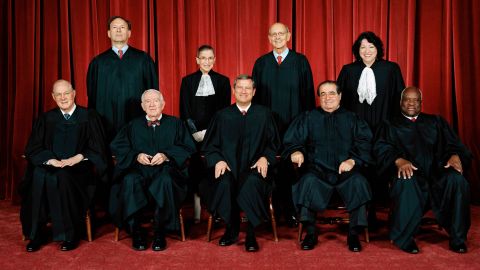Four Things You Need to Know About the Same Sex Marriage Debate

Supreme Court watchers — and that should include all of us this week — are in for a thrilling and nerve-racking ride. The highest court is hearing arguments about the legality of both California’s Proposition 8 ban on same-sex marriage and the federal Defense of Marriage Act (DOMA). These cases are Hollingsworth v. Perry, scheduled to be heard on Tuesday, March 26, and United States v. Windsor, scheduled to be heard on Wednesday, March 27.
How Bold Will the Court Be?
The first big question is just how broad or narrow the court’s rulings will be. For instance, if the court decides to be bold and dramatic, here are two possible outcome we could see:
-In the Hollingsworth case, California’s Proposition 8 is struck down, invalidating statutes against gay marriage in every state.
-In striking down DOMA in the Windsor case, over 1,000 federal statutes involving legally married people would be applied to same sex couples, who would then be eligible to receive benefits such as tax breaks. In the case of the New York woman Edith Windsor who brought the legal challenge, this would mean a $363,000 refund in estate taxes. There are an estimated 120,000 legally married same sex couples in the United States.
On the other hand, the court could follow a different path and restrict their Prop 8 ruling to apply to the specifics of the California law, or even find a legal justification for avoiding the issue altogether (e.g. the two same sex couples who sued the state of California could be found to lack standing).
The New York Times has an informative graphic here on the wide array of options the court has to consider in its rulings, expected to come in June.
Is the War Already Over?
The legal definition of marriage has been contested for decades, but recent polls show that a growing majority of Americans now support same sex marriage. In fact, a Reuters/Ipsos poll released last week found 63 percent of Americans supported gay marriage or civil unions. Moreover, 83 percent expect it will happen, regardless of which side they’re on. This represents a tectonic shift over the last decade.
As Jeffrey Toobin writes in The New Yorker, “the question about marriage equality for all Americans is not if it will pass but when. The country has changed, and it’s never going back to the way it was. Though the battles continue, the war is over.
Consider that 10 years ago — in 2003, consensual sex between same sex couples was still illegal in Texas. And yet, by declaring Texas’s anti-sodomy law unconstitutional, Justice Scalia warned at the time, the Supreme Court would be opening the door to recognizing same sex marriage. Scalia wrote in his dissenting opinion:
If moral disapprobation of homosexual conduct is “no legitimate state interest” for purposes of proscribing that conduct; and if, as the Court coos (casting aside all pretense of neutrality), “when sexuality finds overt expression in intimate conduct with another person, the conduct can be but one element in a personal bond that is more enduring,” what justification could there possibly be for denying the benefits of marriage to homosexual couples exercising “the liberty protected by the Constitution”?
As Toobin notes, it turns out Scalia was absolutely correct, because this is precisely the way public opinion and the law have both evolved over the last decade: “If gay people can’t be prosecuted for being gay, then they shouldn’t be fired for being gay, either. If they can’t be fired, then they shouldn’t be denied custody of children. And so on, to the issue of marriage.”
Who Are the Justices to Watch?
Scalia watchers are already gearing up to see whether “the 78 year old jurist” will “vent his personal and political prejudices” during oral arguments. In other words, the only unknown when it comes to Scalia will be the level of his theatrics in court. No one expects any “epiphanies from the bench” from him.
The two justices whose opinions are most likely to tip the majority one way or the other are Chief Justice John Roberts, whose lesbian cousin Jean Podrasky will be on hand during oral arguments, and Justice Anthony Kennedy, the conservative swing voter who also wrote the majority opinion in Lawrence V. Texas that struck down Texas’s anti-sodomy law in 2003. Along with the court’s four liberal justices, Kennedy could form a majority that affirms gay marriage in California and perhaps other states.
As Roberts showed in his decision last summer to uphold the individual mandate provision of the Affordable Care Act, he is a jurist who cares about the legacy of the court. By all accounts Roberts does not view his court as an activist one. Therefore, Roberts could certainly influence how broadly the court’s decision is applied.
On the other hand, as Peter Lawler notes here on Big Think, the issue of judicial activism should not be confused with that of legislative activism, which is the knock against DOMA. As Lawler points out, conservatives are sympathetic to the argument DOMA is a “violation of the principle of federalism.” That is to say, what Congress did was “impose a national definition of marriage,” which conservative jurists may find is a power that should be granted instead to the states.
How Did We Get Here?
The idea of accelerated social change is not something we’re used to seeing in American history. Instead, we are used to seeing incremental change. That is not to disregard, however, the Supreme Court’s role in accelerating change with landmark decisions by the Warren Court during the Civil Rights era. Nonetheless, there is a long gap in American history between slavery and Selma. The Seneca Falls Convention was held in 1848 and women’s suffrage became enshrined in the Constitution in 1920. By comparison, we’ve come a very long way in the short amount of time since the Stonewall demonstrations of 1969.
As Steven Mazie has pointed out here on Big Think, today we can reasonably expect the court to move in the same direction as public opinion. And few issues have seen such a dramatic change in public opinion as same sex marriage. Why is that?
There are a number of important factors, one being digital media. Could it be that the more connected we are, the more we learn about each other and the more accepting of difference we become? Perhaps. But another crucial factor is that this debate has been framed in a way that appeals to the sensibilities of people across the political spectrum, from liberals to libertarians to conservatives. In the video below, Richard Tafel, founder of the Log Cabin Republicans and Public Squared, tells Big Think that appeals for new rights need to be framed in a certain language that is results-oriented, rather than framing the debate around “a right that’s going to threaten the status quo.”
In this case, proponents of same sex marriage have had considerable success winning over conservatives because they have made the argument that gay marriage is an affirmation of, rather than a threat to, the institution of marriage.
Watch the video here:
Image courtesy of Shutterstock.





